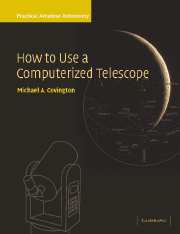Book contents
- Frontmatter
- Contents
- Preface
- Part I Telescopes in general
- 1 Welcome to amateur astronomy!
- 2 How the sky moves
- 3 How telescopes track the stars
- 4 Using equatorial mounts and wedges
- 5 Telescope optics
- 6 Eyepieces and optical accessories
- 7 Astrophotography
- 8 Troubleshooting
- Part II Three classic telescopes
- Index
3 - How telescopes track the stars
Published online by Cambridge University Press: 10 February 2010
- Frontmatter
- Contents
- Preface
- Part I Telescopes in general
- 1 Welcome to amateur astronomy!
- 2 How the sky moves
- 3 How telescopes track the stars
- 4 Using equatorial mounts and wedges
- 5 Telescope optics
- 6 Eyepieces and optical accessories
- 7 Astrophotography
- 8 Troubleshooting
- Part II Three classic telescopes
- Index
Summary
What's inside a computerized telescope
A computerized (or “go to”) telescope is one that finds celestial objects by itself. Well, not exactly by itself – you have to show it the positions of two stars, and from there it can find everything else. Two stars are sufficient to determine the position of the whole celestial sphere.
The telescope takes two kinds of commands. You can tell it to go to a particular object, based on its current knowledge of the position of the sky, or you can tell it to sync (synchronize) on an object that you have identified and centered in the field. The latter is how you tell the telescope the exact position of the sky.
Besides all the parts of an ordinary telescope, a computerized telescope has a computer, motors, and encoders.
Computer
The computer translates right ascension and declination to the position of the telescope on its mount – a coordinate transformation that involves lots of spherical trigonometry (see p. 35).
The software built into the computer is called firmware and contains a built-in catalogue of stars and deep-sky objects, plus algorithms to compute the position of the Moon and planets, so that you can choose objects by name.
Computerized telescopes are a testimony to the low price of powerful computers. The Celestron NexStar 5, for example, has four CPUs in an internal network. Comparable computing power would have cost millions of dollars in the 1960s and would have filled several rooms.
- Type
- Chapter
- Information
- How to Use a Computerized TelescopePractical Amateur Astronomy Volume 1, pp. 19 - 38Publisher: Cambridge University PressPrint publication year: 2002

